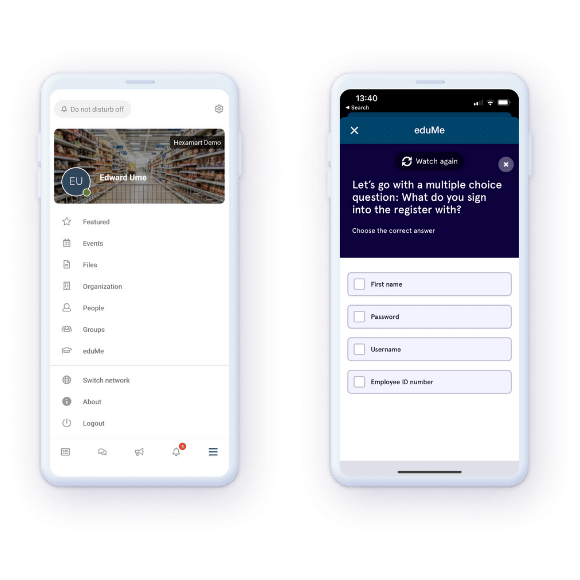TABLE OF CONTENTS
Productivity—it’s a word that carries a lot of weight. Regardless of industry, all businesses aspire to be as productive as possible and are constantly looking for ways to improve their workforce output.
For retail, productivity is a key metric that all managers want to maximize. Why? In short, the more productive your workforce, the better it is for your bottom line.
Understanding what makes a workplace productive has come a long way -gone are the days when managers would watch over employees and demand they do more if unsatisfied with their rate of work.
Today, productivity is a holistic process, and improving it requires the optimization of all business areas, from backroom operations to employee training.
If you’re a retailer who is looking to improve operational efficiency, then keep reading to find out how.

How to Track Shop Floor Productivity
Tracking productivity in retail isn’t as simple as in other industries where people served or products sold are the only metrics that require tracking. Employee ‘effectiveness’ comprises several behaviors that yield both short and long-term results yet aren’t always possible to monitor.
For example, an employee might make 12 sales. However, because they prioritized speed over quality, the customers end up with a negative experience and decide not to return, resulting in a potential loss of earnings.
Despite this, there are some key metrics you can look at to provide a well-rounded picture of shop floor productivity. These include:
-
Task completion rate
-
Time taken to complete tasks
-
Sales per employee
-
Customer satisfaction
These metrics provide a solid foundation for understanding how productive your shop floor is. Retailers should then add others based on their business model.
5 Ways to Improve Shop Floor Productivity
There are many ways for retailers to improve shop floor productivity. However, the strategies listed below can be adopted by most, if not all, retailers and are proven ways of optimizing your workforce.
1. Automate Manual Tasks
Automating manual processes is now a global trend that’s showing no signs of stopping. And for good reason, as it improves productivity, performance and reduces operating costs.
Automation is quickly becoming a cornerstone of retail technologies - not as a replacement for your employees, but as an additional resource.
So, how does automating manual tasks improve shop floor productivity? In short, your workforce are at their best when they’re on the shop floor connecting with customers. They’re the face of the business and need to be available when your customers come calling.
That’s why maximizing their time on the shop floor is vital to productivity. Retailers must assess what manual tasks can be automated, reducing human error and saving valuable working hours that can instead be dedicated to revenue-generating tasks. Businesses that automate certain processes experience a 66% increase in worker productivity.
2. Improve Communication
Internal communication is an area where almost all industries need to improve. 74% of employees feel like they’re missing out on company information, resulting in mass disengagement that costs organizations $450 billion a year.
Effective communication is important for any business that wants to promote productivity, but none more so than those with a deskless workforce.
Because of their hard-to-reach nature, retailers often overlook interacting with their workers, creating a disconnect where company values and goals are lost. Retail employees feel further disconnected, with no place to communicate as a collective.
Employee apps like Speakap specialize in connecting managers with workers, ensuring employees are kept in the loop about workplace events and goals while simultaneously creating a place for workers to engage with one another.
Companies that optimize their communications are seeing staggering changes. 85% of employees said they’re motivated when their company provides regular updates, and this in turn is leading to concrete results, with informed employees outperforming their peers by 77%.
3. Workplace Flexibility
Demand for greater workplace flexibility is growing as workers look to improve their work/life balance. In fact, 60% of workers report wanting more control over their working hours, and 45% are willing to take a pay cut if it means great flexibility.
Gen Z and millennials are especially drawn to flexible working arrangements, and considering that 39% of the retail workforce is now under the age of 28, retailers that provide flexibility are more likely to attract talent and retain their current workforce.
But what does workplace flexibility look like in the retail world? The pandemic accelerated the rollout of working-from-home, and while brick-and-mortar stores can’t offer that, there are ways to meet workers’ demands.
By investing in autonomous scheduling and workforce management, retailers will find it easier to provide fairer scheduling. And with improved communication, workers can organize shift swaps when needed. All of this leads to a happier and more motivated workforce who will likely work harder during shifts they’ve happily been given.
4. Invest In Technology
In retail, technology is a great way to remove hurdles, increase sales, and make your employee’s life as easy as possible. We’ve already mentioned investing in software to automate key business processes, but don’t be afraid to go further.
Self check-outs are now commonplace in retail and speed up the sales process by reducing queues and freeing up staff to help potential buyers and upsell.
Retailers are utilizing QR codes that customers can scan to bring up product information. This would assist customers when staff aren’t available and also act as an aid to your employees who may forget some key information from time to time.
And then there’s wearable technology. Some retailers are utilizing smart watches and headsets to improve the customer experience. In fact, the widespread use of smartwatches and other wearable tech increases workplace productivity by 8.5% and job satisfaction by 3.5%.
It feels like new tech is being released every day and it is important retailers remain informed on potential developments that could help optimize their operations.
5. Relevant and Accessible Training
It’s no secret that retail workers pose a training challenge. They’re constantly on the move and working a variety of shifts, meaning that finding the time and method to train them can prove challenging.
Many retailers fail to adapt to the modern retail worker, delivering lengthy classroom training that pulls staff away from the shop floor for extended periods of time.
This training style poses a number of productivity problems that are easily solved by opting for a training software which enables learning within the flow of work.
Let's take a closer look:
Time consuming - classroom sessions that take several hours will remove your team from the shop floor and naturally reduce their productivity. Instead, choose a microlearning solution so that your workforce can access engaging, bitesize lessons on the go via their mobile devices.
Training delivered sporadically - because classroom training is time-consuming and usually requires additional resources, it’s usually delivered only a few times a year. This fails to account for things like product updates and service expansion. Leverage a training tool which enables you to deliver training right at the point of need, ensuring immediate impact and improving productivity.
Inaccessible training - If your employees need to revisit information, they’ll have to leave the shop floor and access a computer or hard copies, disrupting their workflow and reducing productivity. But with an embeddable training tool like eduMe, information can be delivered within existing tools and accessed at the click of a button.
Training that’s designed to fit around your retail workers’ existing workflows is more engaging and more likely to drive behavior change, leading to increased productivity across your business.
Key Takeaways

As you can see, there’s a lot to think about when trying to improve shop floor productivity. However, the main takeaway is this: you must optimize both your workforce and your workplace. Your employees are only at their best when they’re supported by functioning business operations that keep them on the shop floor for as long as possible. And your workplace investments can only be effectively utilized by a well-trained workforce.
eduMe is a mobile-training platform that can seamlessly integrate into your existing technology, further optimizing your workforce and business operations. Visit edume.com to find out more.
Join 10,000+ frontline leaders
Subscribe to ‘Training the Frontline’ and get weekly insights sent straight to your inbox.


